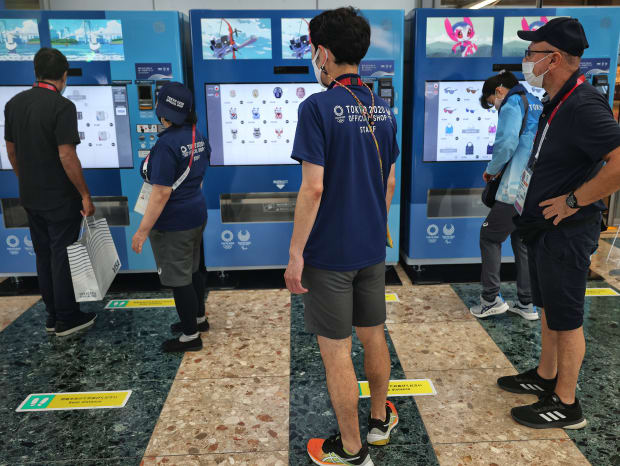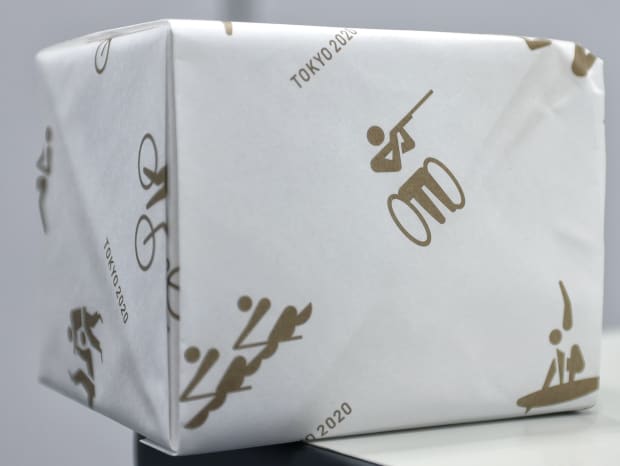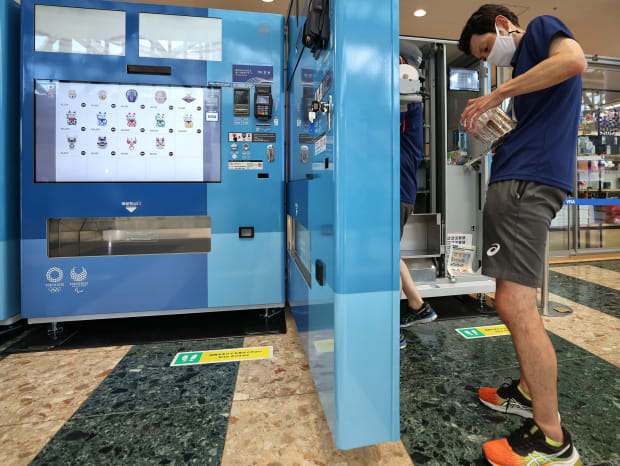Vending machines are a cornerstone of Japanese culture. During the pandemic and the Olympics, these machines take on an even greater importance.
TOKYO – There is the Good Life. There is the Hard Knock Life. And, if there’s no such thing as the perfect life, there is something that comes close, something that Japanese citizens understand, use frequently and love. It’s the Vending Machine Life, and it’s cheap, convenient, versatile and, ultimately, glorious. If there is a heaven for slovenly sportswriters, it would look a lot like the streets of this bustling, machines-every-few-feet metropolis.
Hence the plan: spend one day at the Olympics, before the sports truly get cranking, and lean into the vending machine existence. Study them. Listen to them. Eat from them. Shop from them. And, while COVID-19 restrictions limit most of our movement here, the Japanese, they get me. They know an intrepid vending machine sleuth cannot be stopped.
Which is how I ended up on an escalator Thursday morning, headed to Floor 2, guided by signs to the East Hall of the Main Press Center. In roughly 24 hours, the opening ceremony would begin. But this? This was my personal Olympics, one I had been training for, roughly, all my too-many-calories, too-many-purchases life.

Then, nirvana, at least for the souvenir set. There were five machines standing sentry, like a vending machine offensive line. One, having completely sold out, was being restocked. The others dispensed everything from Tokyo 2020 official Olympic vests to tote bags to sunglasses to mascot dolls to items of cultural significance. But that wasn’t even the best part.
The best part was the video screens near the top of each machine, the ones that showed clips of the official Games mascots crushing unofficial, virtual events. These mascots were chosen by a vote of elementary school students from all over the world, and they looked like stuffed animals met anime met a powerful intoxicant. There’s Miraitowa, the Olympic mascot, the blue one that can teleport, described by organizers as “cheerful and remarkably athletic.” It was inspired by a Japanese proverb: learn from the past and develop new ideas. Then there’s Someity, the Paralympic mascot, the pink one with wings for ears that serve as “cherry blossom tactile sensors” for its telepathic powers and can fly with a “Ichimatsu-pattern” cape.
I almost forgot about the plan as I watched, totally lost, entranced. Miraitowa and Someity shot arrows, threw baseballs, peddled bikes up mountains, paddled boats toward finish lines and even lay on the ground, exhausted from this zany virtual exercise, sucking wind. I didn’t realize a line had formed behind me, and I felt the urge to buy . . . something to justify the 10 minutes I had spent in front of the machine.
This being less-than-flush times for journalism entities, plus my obvious and brilliant plan to expense said purchase—editors: thank you—meant I would not draft for need, but for cost. I settled on the Shirakawa Daruma, an Olympic symbol, in Olympic colors that looks sort of like the largest nesting doll in a set. It was the cheapest product available in the machines, a relative bargain at 2,200 Yen, or about $20. It’s handmade and highlights “many symbols of good fortune,” which was evident, well, immediately.
What happened next encapsulates the Vending Machine Life. Tap the button. Slide in the credit card—Visa only, of course, at Olympic venues. A tray lifts, but rather than retrieve a bottle of soda or a package of chips, my precious gift falls inside. Fireworks explode on the video display as a countdown begins from 15, complete with sound, like an opening ceremony for vending machines of sorts. 15 . . . 14 . . . 13 . . . the receipt comes down . . . 12 . . . 11 . . . 10 . . .the tray descends . . . 9 . . . 8 . . . 7 . . . a box falls, and it’s the doll, only it’s inside a wooden box that’s wrapped in white paper with Olympic logos of various sports. Voilà.

This is the best $20 I’ve ever spent.
It’s also indicative of a larger slice of the Japanese culture, in a country that, if it’s not the vending machine capital of the world, then one that must wonder if there’s another place that consists only of vending machines. Japan already comes close. According to the Japan Vending Machine Manufacturers Association, the country can boast of over 5.5 million machines, or more than the 27 countries in European Union combined. Pause briefly, to consider that such an organization actually exists. According to the same group, these machines, all 5.5 million of them, rake in more than $60 billion every year, as in B.
In Japan, there are vending machines stationed inside buildings and outside buildings. They’re tucked into alleyways, located at train stations, stationed next to restaurants, even part of actual restaurants for overflow crowds. They sell basically everything. As in, literally everything.
For food: fermented soybeans known as natto that may be slimy but provide a breakfast laden with nutrients; dashi, or stock rich in umami, made from dried kelp and bonito; grilled ago, or flying fish, meaning an actual fish, dead and stuffed into a bottle; hamburgers; popcorn; soup made from corn or red adzuki beans; chicken skewers; canned bread; Himalayan salt; meat sauce; snails; fish cakes; jars of jam; fresh bananas; apple slices, with or without skin, complete with packets of honey; even allegedly fresh lettuce.
For drinks, some machines feature dozens of varieties of water from all over the country, a nod to Japan’s fierce attention to detail. Others peddle sake shots, with so many varieties that groups could huddle around them and create their own tasting menu. Still others sell milk, along with hot and cold versions of coffee or lattes. One machine even deploys a multilingual artificial intelligence concierge that recommends drinks based on facial recognition, gauging things like age and gender, and answers questions when asked.
That’s not even the weird stuff. Some machines sell what are called “alternative snacks,” the name indicative of the crunchy scorpion or cricket energy bars inside. Others have hachinoko, or bee larvae, grasshoppers and spicy concoctions known as “devil king of death.”
Many of the machines don’t even unload food, trafficking instead everything from plastic beetles to scented candles to train models to T-shirts to T-shirt/original spice combos. Not to mention vinyl umbrellas in case of rain, portable video game consoles, smartphones, photos of idol bands, Pokémon cards, flowers, flashlights, children’s toys and coin cases. Some feature what’s called a hanko, or a seal that’s like a signature in the U.S. and can be used to make documents official. There’s even one so-called “mystery machine” that sells only boxes wrapped in white paper, so that purchasers do not know what’s actually inside—the equivalent of vending machine gambling. Stranger still: some sell women’s phone numbers; others women’s underwear, described as “used,” but actually manufactured to look that way.
There are reasons for all this, and they stretch beyond the more obvious notion that people all over the world like to buy, eat, wear and collect wildly different things. One list, from a Live Japan story, laid out five reasons for the ubiquity and variety: convenience, for a country that’s infamous for long work hours; safety, in that incidences of vandalism or theft are almost nonexistent; low, fair prices; and minor barriers to entry, in that any citizen can own one machine or another and they require little maintenance or staff costs.
During the pandemic, like with the Olympic store in the press center, the vending machines take on even more importance. Many purchasing the Tokyo 2020 coffee mugs and tote bags did so to avoid entering the actual store and putting themselves at a higher risk of contracting COVID-19. Patrons can also use them when the actual store is closed. One rep, when asked about the frequency of purchases, pointed at the lines. Every machine had one. At 11 a.m.!

I wish I had been able to stop by some of the more exotic ones. But my quest persisted, nonetheless. On a quick morning stroll for a few blocks around my hotel, I counted 25 machines selling all manner of beverages. There were so many options that I panicked, buying a Mountain Dew that tasted like a bag of sugar dumped into a throat, while an older gentleman near the machine swept the entrance to a store. It looked like he saw my purpose and shook his head. Maybe.
Undeterred, I tried some plum juice and a cold brew, two superior options after doing the Dew. I also snagged a matcha pastry. Some of the machines were red, others yellow, others blue and pink and white. Some said thank you in Japanese. Some had cold drinks, signified by a blue label, and warm ones, with red stickers. Some took cash, some took credit and the fancy ones accepted tap payments, using metro cards. Nothing cost more than 150 yen, or roughly $1.35. Take that all Marriotts with one piddly, overpriced machine tucked into a side room in the whole hotel!
The day unfolded along these lines. I bought nectar peach juice, Coke Zero (three), some sort of coffee beverage (also three, sorry doc), water and an orange. I saw more vending machines than ATMs. I drank way too many fluids.
Venturing deeper into the abyss, I stumbled upon one machine that claimed to tell a version of the history involved. It traced the first machine to Alexandria, in 251 BC, saying that it dispensed holy water after patrons inserted a coin into a slot and the heft of the coin triggered the vial to drop like a primitive version of my Olympic souvenir. That nugget strained credulity, but it was not credulity we were after. It also traced the first vending machine in Japan to 1888, which apparently sold tobacco.
From there, the machines evolved from juice dispensers (1950s) to train tickets (60s) to, well, everything else. I consider another coffee, or perhaps another plum juice, or maybe some sunglasses if the mood struck. Alas, the adventure ended, like all life-changing adventures do, sparking something deep but not in regard to culture. No, now I’m resolved: I need to come back, if only to live the Vending Machine life in full.
More Olympic Coverage:
• Unfiltered and Unafraid, Lilly King Is Ready to Make Waves in Tokyo
• U.S. Water Polo Makes History in Opening Match at Tokyo Olympics
• Team USA's Dominant 3x3 Basketball Debut Was Quite the Spectacle
• USWNT Again Shows Its Capacity to Respond in Productive Win Over New Zealand